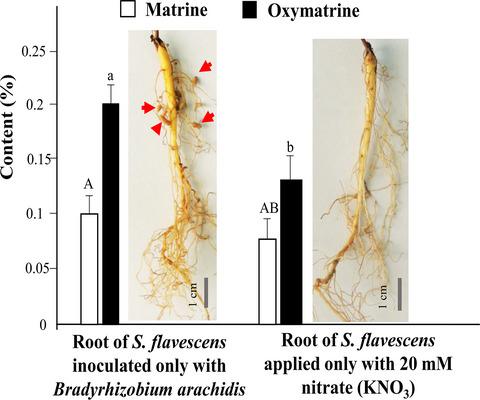当前位置:
X-MOL 学术
›
Lett. Appl. Microbiol.
›
论文详情
Our official English website, www.x-mol.net, welcomes your
feedback! (Note: you will need to create a separate account there.)
Bradyrhizobium arachidis mediated enhancement of (oxy)matrine content in the medicinal legume Sophora flavescens
Letters in Applied Microbiology ( IF 2.0 ) Pub Date : 2021-02-02 , DOI: 10.1111/lam.13453 Zhong Yu Wu 1 , Xiang Fei Meng 1 , Yin Shan Jiao 1 , Bao Lin Guo 2 , Xin Hua Sui 1 , Sheng Jun Ma 3 , Wen Feng Chen 1 , Raghvendra Pratap Singh 4
Letters in Applied Microbiology ( IF 2.0 ) Pub Date : 2021-02-02 , DOI: 10.1111/lam.13453 Zhong Yu Wu 1 , Xiang Fei Meng 1 , Yin Shan Jiao 1 , Bao Lin Guo 2 , Xin Hua Sui 1 , Sheng Jun Ma 3 , Wen Feng Chen 1 , Raghvendra Pratap Singh 4
Affiliation

|
Effect of rhizobial inoculation and nitrate application on the content of bioactive compounds in legume plants is an interesting aspect for interactions among microbes, plants and chemical fertilizers, as well as for cultivated practice of legumes. In this study, nitrate (0 mM, 5 mM and 20 mM) and Bradyrhizobium arachidis strain CCBAU 051107T were applied, individually, or in combination, to the root rhizosphere of the medicinal legume Sophora flavescens Aiton (SFA). Then the plant growth, nodulation, and active ingredients including (oxy)matrine of SFA were determined and compared. Rhizobial inoculation alone significantly increased the numbers and fresh weight of root nodules. Nodulation was significantly inhibited due to using nitrate (5 mM and 20 mM). Only oxymatrine was detected in the control plants without rhizobial inoculation and nitrate supplement, while both oxymatrine and matrine were synthesized in plants treated with inoculation of B. arachidis or supplied with nitrate. The content of oxymatrine was the highest in plants inoculated solely with rhizobia and was not significantly altered by additional application of nitrate. Combinations of B. arachidis inoculation and different concentrations of nitrate did not significantly change the concentrations of (oxy)matrine in the plant. In conclusion, sole rhizobial inoculation was the best approach to increase the contents of key active ingredients oxymatrine and matrine in the medicinal legumes SFA.
中文翻译:

Bradyrhizobium arachidis 介导的药用豆科植物苦参中(氧)苦参碱含量的增加
根瘤菌接种和硝酸盐施用对豆类植物中生物活性化合物含量的影响是微生物、植物和化肥之间相互作用以及豆类栽培实践的一个有趣方面。在本研究中,将硝酸盐(0 mM、5 mM 和 20 mM)和花生根瘤菌菌株 CCBAU 051107T 单独或组合施用到药用豆科植物苦参 (SFA) 的根际。然后测定并比较植物的生长、结瘤和活性成分,包括 SFA 的(氧)苦参碱。单独接种根瘤菌显着增加了根瘤的数量和鲜重。由于使用硝酸盐(5 mM 和 20 mM),结瘤被显着抑制。在没有接种根瘤菌和硝酸盐的对照植物中仅检测到氧化苦参碱,而在接种花生芽孢杆菌或提供硝酸盐的植物中合成了氧化苦参碱和苦参碱。氧化苦参碱的含量在仅接种根瘤菌的植物中最高,并且不会因额外施用硝酸盐而显着改变。花生芽孢杆菌接种和不同浓度硝酸盐的组合不会显着改变植物中(氧)苦参碱的浓度。综上所述,单独接种根瘤菌是提高药用豆科植物SFA中关键活性成分氧化苦参碱和苦参碱含量的最佳途径。氧化苦参碱的含量在仅接种根瘤菌的植物中最高,并且不会因额外施用硝酸盐而显着改变。花生芽孢杆菌接种和不同浓度硝酸盐的组合不会显着改变植物中(氧)苦参碱的浓度。综上所述,单独接种根瘤菌是提高药用豆科植物SFA中关键活性成分氧化苦参碱和苦参碱含量的最佳途径。氧化苦参碱的含量在仅接种根瘤菌的植物中最高,并且不会因额外施用硝酸盐而显着改变。花生芽孢杆菌接种和不同浓度硝酸盐的组合不会显着改变植物中(氧)苦参碱的浓度。综上所述,单独接种根瘤菌是提高药用豆科植物SFA中关键活性成分氧化苦参碱和苦参碱含量的最佳途径。
更新日期:2021-02-02
中文翻译:

Bradyrhizobium arachidis 介导的药用豆科植物苦参中(氧)苦参碱含量的增加
根瘤菌接种和硝酸盐施用对豆类植物中生物活性化合物含量的影响是微生物、植物和化肥之间相互作用以及豆类栽培实践的一个有趣方面。在本研究中,将硝酸盐(0 mM、5 mM 和 20 mM)和花生根瘤菌菌株 CCBAU 051107T 单独或组合施用到药用豆科植物苦参 (SFA) 的根际。然后测定并比较植物的生长、结瘤和活性成分,包括 SFA 的(氧)苦参碱。单独接种根瘤菌显着增加了根瘤的数量和鲜重。由于使用硝酸盐(5 mM 和 20 mM),结瘤被显着抑制。在没有接种根瘤菌和硝酸盐的对照植物中仅检测到氧化苦参碱,而在接种花生芽孢杆菌或提供硝酸盐的植物中合成了氧化苦参碱和苦参碱。氧化苦参碱的含量在仅接种根瘤菌的植物中最高,并且不会因额外施用硝酸盐而显着改变。花生芽孢杆菌接种和不同浓度硝酸盐的组合不会显着改变植物中(氧)苦参碱的浓度。综上所述,单独接种根瘤菌是提高药用豆科植物SFA中关键活性成分氧化苦参碱和苦参碱含量的最佳途径。氧化苦参碱的含量在仅接种根瘤菌的植物中最高,并且不会因额外施用硝酸盐而显着改变。花生芽孢杆菌接种和不同浓度硝酸盐的组合不会显着改变植物中(氧)苦参碱的浓度。综上所述,单独接种根瘤菌是提高药用豆科植物SFA中关键活性成分氧化苦参碱和苦参碱含量的最佳途径。氧化苦参碱的含量在仅接种根瘤菌的植物中最高,并且不会因额外施用硝酸盐而显着改变。花生芽孢杆菌接种和不同浓度硝酸盐的组合不会显着改变植物中(氧)苦参碱的浓度。综上所述,单独接种根瘤菌是提高药用豆科植物SFA中关键活性成分氧化苦参碱和苦参碱含量的最佳途径。











































 京公网安备 11010802027423号
京公网安备 11010802027423号